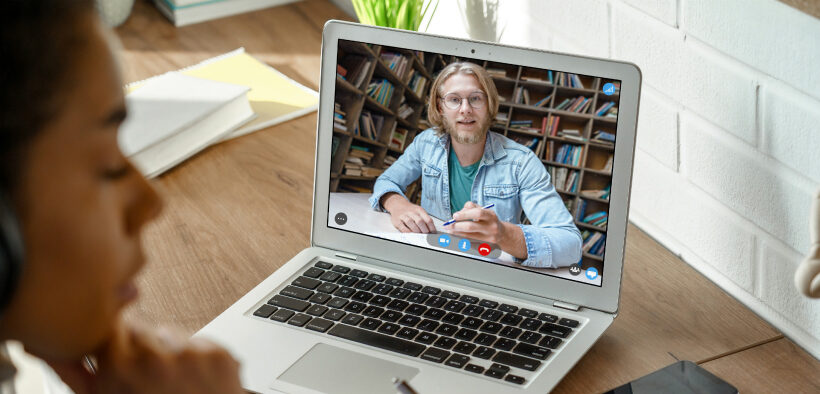I have never used videoconferencing in my online courses on grounds that they undermine the “anywhere, anytime” convenience of online learning. But with Zoom now becoming ubiquitous in the working world due to the COVID-19 pandemic, I have come to see that videoconferencing skills are a valuable learning outcome that we should be teaching our students. Until now higher education has focused on written and face-to-face communication skills, but even after the pandemic has passed, I am sure that videoconferencing will remain a common means of communication in a business world where people routinely meet from different locations.
The Zoom meeting culture today has taught us that video discussion requires communication protocols all their own. For one, the chat function in all videoconferencing software leads to parallel discussions running at the same time. Students can practice at using chat during meetings without losing the thread of the main discussion. Plus, the traditional discussion forum tends to become individuals taking turns expressing opinions for individual grades, making them process oriented. By contrast, video conferences are by nature more about the outcome of the discussion, making them product oriented. In this way video conferences are far closer than asynchronous discussion forums to what students will encounter in organizations after they graduate.
But video discussions can become aimless if they are not carefully scaffolded, and for this reason Rhonda Bondie (2020) provides a framework for guiding students in video discussions. Note that Bondie focuses on small group discussions in her work. Large group video discussions are probably not a good idea because they will not get everyone involved. An instructor interested in using videoconferencing is probably better off giving students group projects that require videoconferencing than substituting an asynchronous discussion forum for a live, class-wide event.
Pre-assignment directions
Many faculty give students a brief description of the product expected of group work but not much in the way of guidance on how to reach that outcome. It is easy to think that because students communicate on their cell phones all the time, they know how to manage discussions. But students are used to communicating by text or one-on-one by video, not in group videos. Plus, academic discussions are a whole different animal from the personal discussions that students have, and as Jennifer Orr (2020) notes, expecting students to simultaneously learn video discussion principles and apply them to unfamiliar academic discussions creates more cognitive load than many can handle. For this reason instructors are better off helping students with discuss techniques with pre-assignment guidance than leaving them to sink or swim.
While most faculty provide students with pre-assignment directions in text-only form, Bondie uses a more visual approach by putting the directions into a slide that combines images and text. For instance, an assignment on how people with disabilities have been portrayed in the media includes images of different portrayals. It has been said that a picture is worth a thousand words because images capture our attention and elicit a variety of responses. Images prime the pump of student thinking in ways that text alone cannot, and faculty often forget that nearly all communication outside of academia contains some visual elements.
Blondie also has students produce an outcome that combines a variety of means of communication, from text to images to video to podcasts. Instead of simply writing a report, she has students use Flipgrid to build a multimedia presentation. My guess is that it is easier for groups of students to assign different tasks for building a multimedia site and a purely text report due to the ease of putting the elements together. Plus, multimedia communication is becoming more common and so is itself a valuable skill to learn.
Scaffolding meetings
Blondie requires each group to assign a “note catcher” for each discussion. I would suggest that these notes are best done in a social editing tool, such as Google Docs, so that everyone can see what is being written down and can suggest corrections at the time. She also provides a template for recording notes, which again can be created in Google Docs and shared with students. This template scaffolds the discussions with requirements specific to each. For instance, a template might require that the team determine a goal at the beginning of each discussion, as well as a product and a reason for the product. Sometimes a meeting opens with each member contributing a thought. This scaffolding ensures that all students participate and contribute something meaningful.
Feedback survey
Blondie also suggests that students should fill out a feedback survey after meetings. These surveys do two things. One, they force students to reflect on how the meetings went with questions on topics such as what was accomplished, what went well and what did not go well, and what can be done to make future meetings more productive. It can also ask each student to think about their contributions and how they handled themselves during the meeting. Did they talk over people or allow each person to speak? What did they learn that they can apply in future meetings? Such self-reflection is critical to learning group collaboration. Two, the feedback surveys allow the instructor to learn whether the assignment or meeting format needs to be revised.
Live video discussions have a valuable place in online education as a supplement to the traditional discussion forum. Properly set up and scaffolded, these discussions teach students valuable skills that they will need beyond the classroom.
References
Bondie, R. (2020, April 23). Practical tips for teaching online small-group discussions. ASCD Express, 15(16). http://www.ascd.org/ascd-express/vol15/num16/practical-tips-for-teaching-online-small-group-discussions.aspx
Orr, J. (2020, April 23). Helping students balance the cognitive load in academic discussions. ASCD Express, 15(16). http://www.ascd.org/ascd-express/vol15/num16/helping-students-balance-the-cognitive-load-in-academic-discussions.aspx
To sign up for weekly email updates from The Teaching Professor, visit this link.








